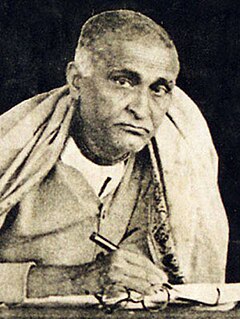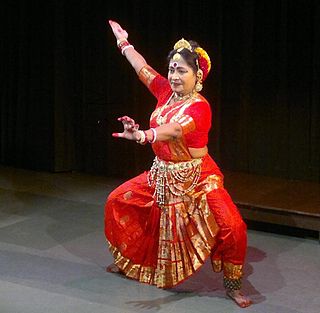External links
| Forms | ||
|---|---|---|
| Consorts | ||
| Other relatives | ||
| Worship | ||
| Holy sites |
| |
| Epigraphy | ||
| Texts |
| |
| See also | ||
| | This Hindu philosophy-related article is a stub. You can help Wikipedia by expanding it. |
The word "prayojana" is a Sanskrit term which denotes the ultimate goal or object of attainment. Along with sambandha and abhidheya, prayojana is one of the three fundamental concepts in Gaudiya Vaishnava theology, where it is used to describe the ultimate goal of life - Prema, or pure love of Krishna.

Shri Krishna Chaitanya Mahaprabhu was a 15th century Indian saint and the combined avatar of Radha and Krishna. Chaitanya Mahaprabhu's mode of worshipping Krishna with ecstatic song and dance had a profound effect on Vaishnavism in Bengal. He was also the chief proponent of the Vedantic philosophy of Achintya Bheda Abheda Tattva. Mahaprabhu founded Gaudiya Vaishnavism. He expounded Bhakti yoga and popularized the chanting of the Hare Krishna Maha-mantra. He composed the Shikshashtakam.

Bhaktisiddhanta Sarasvati, born Bimla Prasad Datt, was a Gaudīya Vaisnava Hindu guru, ācārya, and revivalist in early 20th century eastern India. To his followers, he was known as Srila Prabhupāda.

Gaudiya Vaishnavism, also known as Bengali Vaishnavism, Chaitanya Vaishnavism, the Chaitanya/Gaudiya Sampradaya and Gaura Dharma, is a Vaishnava Hindu religious movement inspired by Chaitanya Mahaprabhu (1486–1534) in India. "Gaudiya" refers to the Gaura or Gauḍa region of Bengal, with Vaishnavism meaning "the worship of Vishnu". Specifically, it is part of Krishnaism—Krishna-centric Vaishnavite traditions. Its theological basis is primarily that of the Bhagavad Gita and Bhagavata Purana, as interpreted by early followers of Chaitanya, such as Sanatana Goswami, Rupa Goswami, Jiva Goswami, Gopala Bhatta Goswami and others.

Bhaktivinoda Thakur, born Kedarnath Datta, was a Hindu philosopher, guru and spiritual reformer of Gaudiya Vaishnavism who effected its resurgence in India in late 19th and early 20th century and was hailed by contemporary scholars as the most influential Gaudiya Vaishnava leader of his time. He is also credited, along with his son Bhaktisiddhanta Sarasvati, with pioneering the propagation of Gaudiya Vaishnavism in the West and its eventual global spread.

Mayapur, previously known as Miyapur, is a neighbourhood of Bamanpukur, West Bengal, India, situated adjacent to Nabadwip, at the confluence of two rivers, where the waters of the Jalangi River mix with Bhagirathi, a distributary of the Ganges, called Ganga by the Hindus. It is located about 130 km north of Kolkata. Along with Nabadwip, it is considered a spiritual place by the adherents of Gaudiya Vaishnavism.

The Gaudiya Math is a Gaudiya Vaishnava matha formed on 6 September 1920, about 30 months after Bhaktisiddhanta Sarasvati took sannyasa, the renounced order of life. On 7 March 1918, the same day he took sannyasa, he established the Sri Chaitanya Math in Mayapura in West Bengal, later recognised as the parent body of all the Gaudiya Math branches. Its purpose was to spread Gaudiya Vaishnavism, the philosophy of the medieval Vaisnava saint Chaitanya Mahaprabhu, through preaching and publishing.

Rupa Goswami was a devotional teacher (guru), poet, and philosopher of the Gaudiya Vaishnava tradition. With his brother Sanatana Goswami, he is considered the most senior of the six Goswamis of Vrindavan associated with Caitanya Mahaprabhu, a hidden avatar (incarnation) of Krishna in Kali Yuga.

Sanatana Goswami was a principal follower of Chaitanya Mahaprabhu. Sanatana wrote a number of important works in the bhakti tradition of Gaudiya Vaishnavism and was the seniormost of the influential Six Goswamis of Vrindavan, among whom was his brother Rupa Goswami.

Jiva Goswami was an Indian philosopher and saint from the Gaudiya Vaishnava school of Vedanta tradition, producing a great number of philosophical works on the theology and practice of Bhakti yoga, Vaishnava Vedanta and associated disciplines. He is known as one of the Six Goswamis of Vrindavan and was the nephew of the two leading figures, Rupa Goswami and Sanatana Goswami.

Advaita Acharya, , was a companion of the founder of the Gaudiya Vaishnava movement, Chaitanya Mahaprabhu, and guru of Haridasa Thakur. He was born in the village of Nabagram in Laud, in 1434, some fifty years before Chaitanya, and spent most of his adult life in the town of Shantipur in Nadia with his wife and family. Advaita Acharya had six sons, Acyutananda Das, Krisna Mishra, Gopala Das, Balarama Das Mishra, Swarupa Das and Jagadisa Mishra.
Bhedābheda Vedānta is a subschool of Vedānta, which teaches that the individual self (jīvātman) is both different and not different from the ultimate reality known as Brahman.

Goloka, or Goloka Vrindavan, is the eternal supreme abode of the Hindu god Krishna and his consort Radha. In the Bhagavata Purana, Krishna is portrayed as the highest person who resides in Goloka.

In Hinduism, the Brahma Sampradaya is the disciplic succession (sampradaya) of gurus starting with Brahma. The term is most often used to refer to the beliefs and teachings of Madhvacharya and his Dvaita philosophy.

Bhakti Prajnan Keshava, addressed by the honorific Mahārāja, was a disciple of Bhaktisiddhanta Sarasvati and the founder of the Gaudiya Vaishnava religious organisation Sri Gaudiya Vedanta Samiti, formed in Calcutta in 1940.
The word "abhidhéya" is a Sanskrit term which, along with sambandham and prayojana, is one of the three fundamental concepts of Gaudiya Vaishnavism. It denotes a means of achieving the ultimate goal, dedicated ministry in the stage of practice Sadhana-Bhakti. Abhidheya is what a person must develop to achieve the ultimate goal—prem, or pure love of Krishna, which is considered the highest achievement of the prayojana.
The word "sambandha" is a Sanskrit term meaning "relationship". It is a key concept in Sanskrit grammar, and in Gaudiya Vaishnava theology. In the context of this tradition of Hinduism, sambandha-jnana means knowledge of the relationship between Almighty God Krishna, Shakti, jivas, and the world. Accordingly, sambandha-jnana includes knowledge of the three tattvas or truths: Krishna-tattva, Shakti-tattva and jiva-tattva.
Padārtha is a Sanskrit word for "categories" in Vaisheshika and Nyaya schools of Hindu philosophy.

Gaudiya Nritya or Gauriya Nritya, is a Bengali dance tradition. It originates from Gauda, also known as Gaur, in Bengal.

The Gaudiya Mission is a Gaudiya Vaishnava monastic and missionary organization registered since March 1940 in Calcutta, British India. Its founder acharya is brahmachari Ananta Vasudev Prabhu alias Bhakti Prasad Puri Maharaja after accepting sannyasa in 1939.